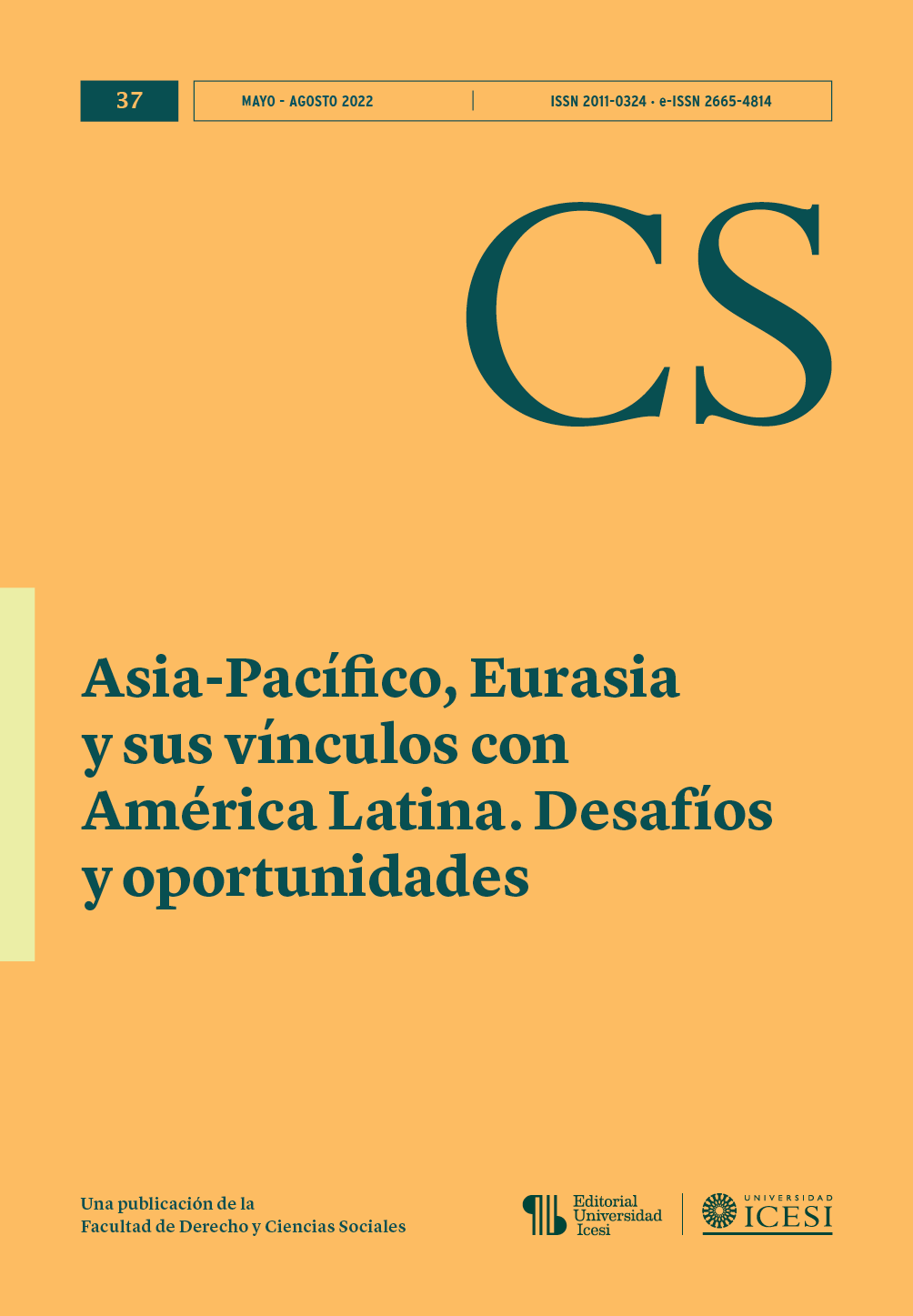Asia, 21st Century: An Opportunity to Diversify the Colombian Foreign Policy
DOI:
https://doi.org/10.18046/recs.i37.5162Keywords:
Foreign Policy, Latin American Integration, Asia, International System, ColombiaAbstract
Asia was reborn as a continent with great productive, commercial, and innovation capacities that have impacted the international system, thus challenging Colombian foreign policy. Over the last century, the accepted subordination to US global strategic design was the main characteristic of this country’s foreign policy. The objective of this article is to present the requirements that an assertive response implies in face of the Asian global challenge. In this regard, it is argued that, given the size and development conditions of Colombia, a policy towards Asia requires improving its negotiation capacity. This requires a robust Latin American regional integration program. In the domestic context, it is also essential to advance the democratization of the external agenda by enriching the deliberation process via the incorporation of new agents, beyond bureaucratic teams, and the business community.
Downloads
References
Ardila, Martha (1991). ¿Cambio de norte? Momentos críticos de la política exterior colombiana. Bogotá: Tercer Mundo.
Bermúdez, César (2012). Colombia en los recientes esfuerzos de integración latinoamericana. Perspectivas Internacionales, 8(2), 62-89.
Berry, Albert (2014). Legal, Political and Economic Aspects of the Tragedy in Rural Colombia in Recent Decades: Hypothesis for Analysis. Estudios Socio-Jurídicos, 16(1), 25-41.
Burin des Roziers, Philippe (1983). La Colombie : oligarchie et démocratie restreinte. Espirit, 82(10), 165-178.
Browitt, Jeff (2001). Capital Punishment: The Fragmentation of Colombia and the Crisis of the Nation-State. Third World Quarterly, 22(6), 1063-1078.
Cancillería de Colombia (19 de agosto de 2021). Política Exterior. Recuperado de https://www.cancilleria.gov.co/international
Chomsky, Noam (2017). Who rules the World? New York: Metropolitan Books.
Conferencia de las Naciones Unidas sobre Comercio y Desarrollo (7 de diciembre de 2020a). Trade structure by partner. Recuperado de https://unctad.org/system/files/official-document/tdstat45_FS02_en.pdf
Conferencia de las Naciones Unidas sobre Comercio y Desarrollo (2020b). The Regional Comprehensive Economic Partnership. Geneva: United Nations.
Departamento Administrativo Nacional de Estadísticas (septiembre, 2021). Comercio internacional. Recuperado de https://www.dane.gov.co/index.php/estadisticas-por-tema/comercio-internacional
Drekonja, Gerhard (1983). Colombia: en búsqueda de una política exterior. Revista de Estudios Internacionales, 4(2), 259-280.
Drekonja, Gerhard; Tokatlian, Juan (1983). Teoría y práctica de la política exterior latinoamericana. Bogotá: Universidad de los Andes.
Eckhardt, Fuchs; Kasahara, Tokushi; Saaler, Sven (eds.), (2018). A New Modern History of East Asia. Göttingen: V&R Unipres GmgH.
Fajardo, Carlos (2016). Colombia y su interminable paternalismo feudal. Artelogie, 9, 1-16.
Fawcett, Louise; Posada, Eduardo (1998). Árabes y judíos en el desarrollo del Caribe colombiano, 1850-1950. Boletín Cultural y Bibliográfico, 35(49), 2-29.
Forum for East Asia-Latin America Cooperation (s.f.). About FEALAC. Recuperado de https://www.fealac.org/new/about/overview.jsp
García, Pío (1991). Colombia en la era del Pacífico. Bogotá: Universidad de los Andes.
García, Pío (1995). Alcances y límites del APEC. Colombia Internacional, 32, 30-34.
García, Pío (1997). APEC como instrumento de la proyección colombiana en el Pacífico. Colombia Internacional, 39, 4-8.
García, Pío (2011). La importancia de FOCALAE para Colombia. Oasis, 16, 163-187.
García, Pío (2014). Escrutinio de la Alianza. Perspectiva Empresarial, 1(1), 83-93.
García, Pío (2018). La Alianza del Pacífico y Colombia ante la escalada china. Estudios Políticos, 52, 15-35.
Ghotme, Rafat (2007). La historia de las relaciones internacionales en Colombia. Una hojeada a la literatura sobre la fase republicana, 1820-1903. Revista de Relaciones Internacionales, Estrategia y Seguridad, 2(2), 33-62.
Maddison, Angus (2001). The World Economy : A Millennial Perspective. Paris: OECD.
Ministerio de Comercio, Industria y Turismo (15 de abril de 2021). Colombia. Recuperado de https://www.mincit.gov.co/getattachment/1c8db89b-efed-46ec-b2a1-56513399bd09/Colombia.aspx
Mora, Óscar (2010). Los dos gobiernos de Alfonso López Pumarejo: Estado y reformas económicas y sociales en Colombia (1934-1938, 1942-1945). Apuntes del CENES, 29(50), 151-171.
Muñoz, Catalina (2011). Los problemas de la raza en Colombia. Bogotá: Universidad del Rosario.
Pardo, Rodrigo; Tokatlian, Juan (1988). Política exterior colombiana: ¿de la subordinación a la autonomía? Bogotá: Tercer Mundo.
Sanmiguel, Inés (2006). Japoneses en Colombia. Historia de inmigración, sus descendientes en Japón. Revista de Estudios Sociales, 23, 81-96.
Santander Trade Markets (septiembre, 2021). Mexican Foreign Trade in Figures. Recuperado de https://santandertrade.com/en/portal/analyse-markets/mexico/foreign-trade-in-figures
Schott, Jeffrey (3 de enero de 2022). Which Countries are in the CPTPP and RCEP Trade Agreements and which Want in? Recuperado de https://www.piie.com/research/piie-charts/which-countries-are-cptpp-and-rcep-trade-agreements-and-which-want
Tickner, Arlene (2007). Intervención por invitación. Claves de la política exterior colombiana y de sus debilidades principales. Colombia Internacional, 65, 90-111.
Vargas, Ricardo (12 de agosto de 2021). Los contextos complejos del mercado de drogas: desafío crucial y alternativas. Le Monde Diplomatique, pp. 4-5.
Downloads
Published
Issue
Section
License
Copyright (c) 2022 Pío García

This work is licensed under a Creative Commons Attribution-NonCommercial 4.0 International License.
© Reserved Copyright
Material in this publication may be reproduced without authorization, provided the title, author and institutional source is acknowledged.
The content published in Revista CS is distributed under the Creative Commons BY-NC 4.0 Attribution/Recognition-NonCommercial 4.0 International license.
You are free to:
Share — copy and redistribute the material in any medium or format.
Adapt — remix, transform, and build upon the material.
Under the following terms:
Attribution — You must give appropriate credit , provide a link to the license, and indicate if changes were made . You may do so in any reasonable manner, but not in any way that suggests the licensor endorses you or your use.
NonCommercial — You may not use the material for commercial purposes.












